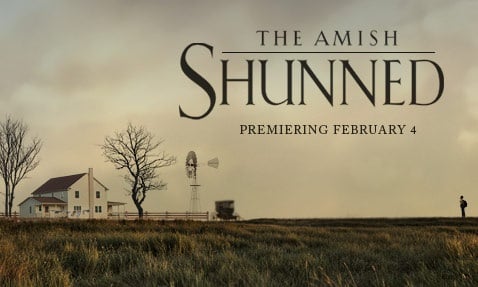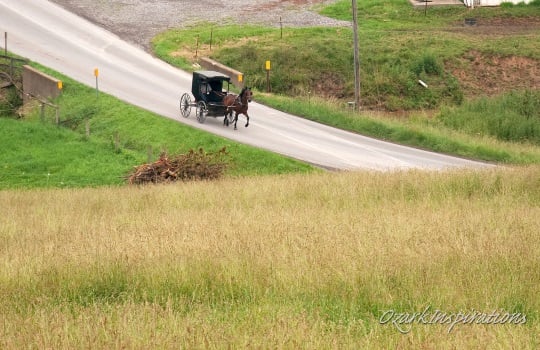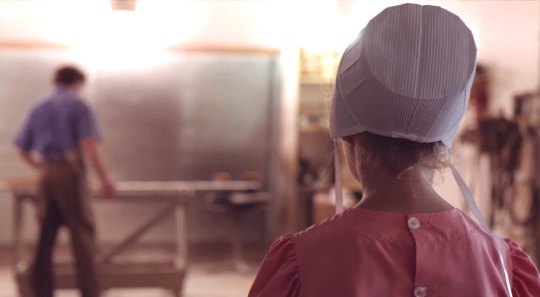A Review of “The Amish: Shunned”
I just had a chance to watch an advance copy of the new PBS film The Amish: Shunned.
I’ve never been, and never will be, an excommunicated Amish person, and so don’t know what that’s like. But I’ve heard enough stories from both sides to know that it can’t be easy.
That’s why I was curious about this film. I think this is a difficult subject to do a film about, for various reasons, including doing justice to both the Amish and former Amish perspectives.

That’s why I was pleasantly–surprised is not the right word, as PBS and writer/director/producer Callie Wiser have a track record with their previous film–let’s just say pleased to see what the film achieves. Having now viewed it twice, I can share a little bit about it.
First I will say that The Amish: Shunned carries a number of the positive elements of the first PBS film on the Amish in 2012, including beautiful cinematography and significant Amish participation.
Missing in this one are the expert voices explaining the Amish, which is an interesting choice. This leaves it to each side to tell their story without interpretation by an academic speaker. The film thus feels a bit more raw, though that’s not necessarily a bad thing.
You are getting former Amish people’s first-person stories, and whether or not you think the Amish system of church discipline is a good or bad thing, you can see these people have been through difficult experiences.
You can also see they are conflicted. Most seem to miss what they’ve left behind even when balanced against the excitement and fulfillment some of them are finding in their new lives.
Some of the descriptions of the excommunicated individuals present a harsh picture of their Amish families and churches. For instance, one speaker says that his father told him that if he didn’t return, he’d “cut you off forever”. Fear of dying and going to hell arises more than once.
The Amish people they are talking about are not there to rebut or confirm what they say. But Amish voices do appear interspersed throughout the film, giving the general Amish perspective.
Three points on “The Amish: Shunned”
There are a lot of things one could discuss about this film, but I wanted to touch on three:
1. Freedom vs. Family. As mentioned previously, the film’s “Your Freedom or Your Family” tagline jumped out at me in the original clip. It seemed a particularly bleak way to paint it–for the implication that if you choose the Amish, you forgo freedom in the captivity of Amish society.
But for the former Amish participants here, that picture may be close to the mark. Some speakers emphasize the freedom aspect of their decisions. Particularly given their highly traditional backgrounds, the contrasts between Amish life and non-Amish life must have been stark.
The film’s Amish speakers also have a chance to discuss freedom. One Amish woman suggests that if you know and respect your boundaries, “it brings a freedom”. Another challenges the formula for happiness of “maximiz[ing] our pleasure and minimiz[ing] our pain”.
Home is a huge part of this film. A number of the former Amish suffer from lack of home. Their freedom has been achieved by sacrifice of things they hold dear, like a close relationship with family.
Leaving aside the question of how much freedom may be found within and without the Amish, there is a trade-off involved in choosing to be Amish. Though if you’re raised in the society, it may feel like less of a trade-off than if you are someone who joins the Amish.
2. Edwards Family. Which brings us to our next topic. The story of the Edwards is one you may not have heard much of before, though they have appeared in at least one other national news program. The Edwards family, including mother Jan and son Paul, joined the Swartzentruber Amish in Ohio in the 1980s.
As Paul admits at one point, “we had no idea what it meant to be Amish”. Though Paul even rises to a position of church leadership, things don’t work out for the family. Their story provides an interesting alternative example, of people who came from the outside, joined the most conservative Amish of all, and are now back outside the church.
3. Balance. How balanced will this be? was a question raised in our previous post. The film features seven former Amish: Anna, Saloma, Naomi, Levi, Joe, Jan, and Paul. There are about the same number of individual Amish voices interspersed among the former Amish stories.
However, and as you might expect, there is a lot more speaking and screen time alloted to the former Amish. I counted a total of eight Amish speaking segments, of maybe a few minutes each. But it actually feels a lot more balanced than this might suggest, for a few reasons.
Probably the least important reason, though still worth mentioning, is that much of the imagery is of scenes from everyday Amish life. Like the first film, this film is beautifully shot. These attractive and sometimes moving images of Amish families going about daily life do some of the “speaking” for the Amish.
Another, more consequential, reason is that the Amish commentary feels more focused–in each segment the Amish perspective on faith, family, and church order is given, concisely and often powerfully by a male or female Amish speaker.
Finally, the former Amish voices are not unsympathetic to their Amish pasts. They are still drawn to their former communities, and you can tell in many cases appreciate what they have left behind. On more than one occasion they actually articulate a number of positive reasons why someone might wish to remain Amish. For the most part, they don’t seem so much bitter as aware of loss, while resolved to their current paths.
Watch The Amish: Shunned
This is not an academic treatment of shunning, but like the first PBS film on the Amish, there is a strong experiential element. You’re hearing seven people’s highly personal stories, and it goes without saying that people have different experiences.
Of the seven whose stories are featured, it looks like four or five are from a highly conservative, mostly Swartzentruber Amish, background. All things being equal the people from the most traditional Amish backgrounds are probably the ones who are going to have the more vivid and painful experiences, for reasons including a greater gap between cultures and the stricter form of shunning typically practiced in those churches.
To learn more about Amish faith I would still seek information in other sources including reading about it. But I think this film does a very nice job of presenting the general Amish perspective against a collection of former Amish stories, which though they may not represent every former Amish person’s experience, deserve to be heard.
Those stories can be very moving, and in particular the final scene of the film. Even if you find your sympathies, for whatever reason, already lie with one side or the other, I’d definitely watch this film if you get the chance.
The Amish: Shunned – New Preview Clip
We have been given a new preview clip by PBS. In it, an Amish man talks about his time away from the Amish, and both the enticements and drawbacks of life in the city. He also shares the powerful tale of another man’s journey away from and back to his community. The film airs in full on Tuesday, February 4th at 9pm.








In reading this post and seeing the video clip, I look forward to watching The Amish: Shunned”.
Katie Troyer, Miah liebe dich…!
Been Waiting
I’ll be looking forward to it!
Erik,
Thanks for the interesting review. You, of all people, would understand both sides of the issue. I wasn’t sure if it was going to be another “Reality” nightmare or if it was something we’d all get something from. I look forward to seeing this, as PBS seems to do pretty well overall with their productions. I hope we can (as a website family) discuss this at a later point.
G.
As an outsider I don’t know that I can understand both sides more than in an abstract way, but I appreciate the comment Galen. The film is very professionally done and definitely not “reality” in the pejorative sense. And yes I think we’ll have another post which will give a chance to comment after people have seen it.
Im looking forward to seeing both of these shows..
If anyone else can not find a listing for the show, try doing a search for “American Experience”. This is how it is listed on U-Verse here in NE Ohio.
That is how I finally was able to find it in my TV listings and set to record it.
It had listings for both “The Amish” shows.. so I’m recording both so I can have myself a nice tv watching day.
Here’s a link to the first film, viewable in full on PBS’s website (may or may not be viewable outside the US):
http://video.pbs.org/video/2200745636/
Unfortunately not viewable in Belgium, so I’m guessing also in other countries outside the US.
After reading the review above, I’m curious and want to watch it though (both). I’ll have to look for it when I have the time and hope I can find a way to watch it.
Thanks for posting that link, Erik. It is an educational and thought provoking documentary of the Amish.
Thanks for posting that link, Erik. It is an educational and thought provoking documentary of the Amish, two hours l
I am very interested to watch this show. After researching and reading about the Amish culture and beliefs I changed my opinion of their practice of shunning. Unfortunately many people who see this will focus on the seemingly negative stories and not take the time to research and understand yet another way of life different from their own. Or, to realize that each persons experience of the same and/or interpretation of a doctrine is different. I look forward to the discussion of this program.
what The bible say about shunning
Please read http://www.openbible.info/topics/shunning
The American Experience–The Amish was just on 2 nights ago, and my children (11, 9, 8, 5) asked if they could watch it (we have strict rules on what they can and cannot watched). After giving my consent, they rushed into the living room and turned the TV on. They were completely fascinated by the show. Whenever words would pop up on the screen, my oldest would quickly read it for the youngest, so she could follow along. I’m planning to DVR The Amish–Shunned, watch it then let my children see it if they want too.
Thanks for the review Erik!
The Amish Shunned
I always look forward to programs on the Amish, I look forward to this one as well.
WOW!
Thanks for sharing this Erik. I can’t wait to see it. The story of the family who joined the Amish, to leave later, will be of special interest to my family. But I must say, the closing story of this clip resonates with me, and reminds me of what Ed saw in the lives of the Amish. Family life, simple and the way God meant it to be lived (though in a fallen world) seems to be what they will show in an artful and beautiful way. Can’t wait to see it, thanks again!
Related Book
For those of you who watch the documentary and become interested to find out more about the experiences of one of the women who is featured: you can read Saloma Miller Furlong’s story in Bonnet Strings: An Amish Woman’s Ties to Two Worlds. The book is available here: http://store.mennomedia.org/Bonnet-Strings-P4179.aspx.
The book you mentioned
I want to thank you very much for telling us about the book! I just watched the second show this morning and felt a little let down. I shall look for this book now! As for the show itself (both) I was wary of watching at first as I have been totally upset over some recent reality shows and was worried that this would be the same! I am glad now that I got to watch them as I feel they were much more respectful in these shows. There is so much good in the Amish lifestyle and I’ve been unhappy about the other shows! PBS did a wonderful job overall and I’m now happy to find that book you mentioned to read more! In closing, another very respectful book I have treasured over the years is titled
“Roseanna Of The Amish” it is based on a true story! The gentleman who wrote it is her son or grandson so it’s true! There was a sequel to it years ago which I also read but have since lost sad to say as it’s not in print anymore! Thank you again!
Roseanna of the Amish
here are quite a few copies on Ebay if you are interested…
Show
When is the show on?
The Amish: Shunned air time
Tuesday, Feb 4, 9-11pm EST on PBS.
Shunning seems like bullying
I’m looking forward to this program, but right now, let me just say this: we have a grandson with autism. His school is trying to mainstream him as much as possible, but he is ignored by the other kids because he is different. To put it another way, he is being shunned. His grandfather saw this at once for what it is: he said, this is bullying.
to forsythia
I was a special person in school if you know what I mean
I was just a bad kid not want to learn after that No kids would talk to me and just stared at me One kid told me that the teacher told them I was to Dum to be with other. I THINK THE REASON the kids didn’t want to talk to me is they don’t want others to make fun of them. Yes I was SHUNN
For Guy
Kids can be mean, and I am sorry kids were mean to you. I think you’re right about the reason–they didn’t want to be made fun of too, so they kept their distance from you. Sometimes there’s a kid with the strong personality who does not go along with the others and refuses to be mean to anyone. I wish there was a way to encourage more kids to be brave like that. I am sorry for your suffering.
I’m sorry for your grandson’s suffering, but please understand that many children are probably not trying to hurt or shun him. Young children have a hard time playing with one another under the best of circumstances at sometimes, for them, trying to play with a non neuro-typical child can be scary. Perhaps their school can do more to teach their students what autism is and how to interact in a good way with autistic children. My own children have come home with what they explain as “scary” stories about what autistic children have done in their classrooms. We talk about these and how they can be kind and interact with their autistic classmates, but because I don’t know these children, or where they are on the spectrum, the best I can help them with is basic kindness. I hope your grandson will find friends who love him and understand him, but pegging all children as “bullies” because they haven’t been able to to negotiate and engage with a child who may interact very differently (because, perhaps, of fear) is not necessarily intentional cruelty.
To Annette
Thank you for your kinds words. My grandson’s public school is a good school, with a program for kids on the autism spectrum who come from the northern part of the county. His “team” is trying to address the problem and I have to give them credit for that. One contributing factor could be that he is the only one from the autism homeroom who is more or less mainstreamed in the 5th grade math, science, social studies and language arts classes. This sets him apart, as he comes in from his homeroom and returns there at the end of the day. He has only gradually this year worked up to staying in the mainstream classes for most of the hour. Last year, he could tolerate only about 20 minutes per class, so he is making progress.
There Is a Difference
Forsythia:
I must say that other children deliberately avoiding your grandson is bullying, and should NOT be tolerated. However, this is not religous shunning.
The Bible talks on shunning: “Now I beseech you, brethren, mark them which cause divisions and offences contrary to the doctrine which ye have learned; and avoid them. For they that are such serve not our Lord Jesus Christ, but their own belly; and by good words and fair speeches deceive the hearts of the simple.” Romans 16:17-18
This helps to minimize strife in church (and thus community) life.
To KJV Conservative
Thanks for pointing out the difference between bullying and religious shunning. I hadn’t thought of that. Years ago, Mom became friends with an Old Order Amish woman who cleaned her house once a week. The woman’s husband had smoked since youth. The day came when Mom’s friend was told by the man/men in authority that she should shun her husband by refusing to eat with him during meals. Mom’s friend said, “I am not shunning anybody.” After the family moved to Indiana, they became New Order Amish. When Mom was 99 and very near the end of her life, her old friend–who had traveled a great distance to attend a wedding–went out of her way to pay Mom a visit. SHe had her Mennonite friends drop her off at our house, where Mom now lived. “E” rang the doorbell at 8 AM. She spent an hour with Mom, talking over old times. I will always remember “E” for her kindness.
Shunned
Thanks for the post Erik, looking forward to seeing the broadcast. Even more interesting will be the discussions after the show and how each of us interpreted what we saw. Keep up the good work Erik, I always look forward to your posts !
Glad to hear this Brad and everyone else who commented. We’ll have another post up that day for comments from those who’ve viewed it and want to share thoughts. Also, here is an interview from yesterday’s Plain Dealer with Don Kraybill with some comments on shunning in general & other topics.
http://www.cleveland.com/entertainment/index.ssf/2014/01/the_amish_shunned_on_pbs_a_rar.html
One of the questions he was asked:
How do we know that there’s truth in the often-cited figure that 90 percent of the Amish don’t leave the church?
Church records. In Geauga alone, there is a 600-page directory of families that includes members and those who left. The number that stays Amish fluctuates by group. In one group it could be 60 percent; in another, 95 percent. Ninety percent is the gross national average. The Swartzentrubers have the higher retention, and, ironically, they’re the most conservative. The “new order” in Holmes has a lower retention rate. The closer you are to the outside world, the easier it is to step over the line.
One question about pre-baptized kids . . .
I live in the heart of Indiana’s Amish country, but like most of the “English” I have no Amish friends. Certainly I have interacted with the Amish, and have had professional relationships with people who grew up in an Amish family but have not lived an Amish life in many years. In that kind of environment, some things one just picks up by osmosis, but I don’t always know how accurate such ideas are.
Can someone tell me if this is correct: I am under the impression that if a young person chooses to leave Amish life BEFORE being baptized, that person is not shunned, and can have relatively normal, if somewhat awkward, relationships with their family; they never were Amish, technically, so they have not “left” the church. The problem is if they leave after baptism. Is that correct, or perhaps correct for some communities and not others?
Trish what you describe is how it is supposed to work, though it’s my understanding that sometimes relationships may be more awkward than in others. I guess we have one example of that in this film with Levi, who was actually not baptized as Callie shared in the Q and A. https://amishamerica.com/callie-wiser-on-the-amish-shunned/
Amish Shunning
Just like there are English and there are English, and there is a wide spectrum of ways between them, so are the Amish. You cannot compare the Swartzentruber ways with the New Order ways because they are so varied. I do wish that when people did videos and wrote articles about the Amish that they would distinguish them as being a particular Amish and not lump them all together. I have been witness to Amish whose District has relaxed the shunning rules, and yet viewing the shunning video one would believe that all shunned Amish were treated as many of those in the video and never brought back to family life again.
I just watched this. I need to process my thoughts so that I don’t sound rude or insensitive to anyone involved (I believe Saloma reads and replies to Amish America, for instance) or anyone who has a similar situation.
I just wanted to tell you that I did sit down and watched this film.